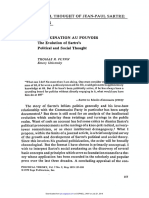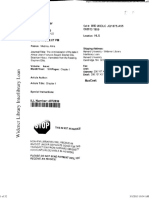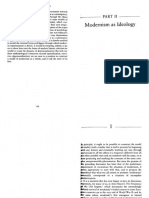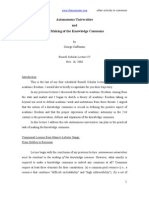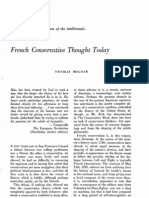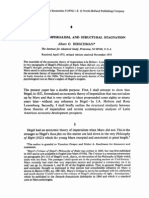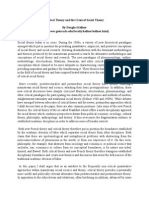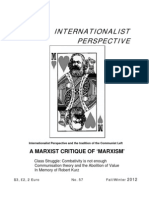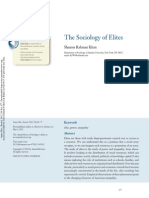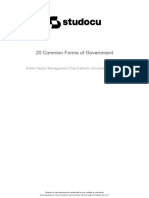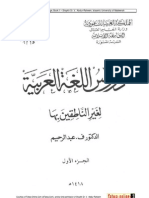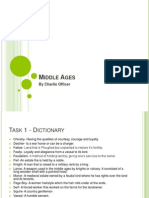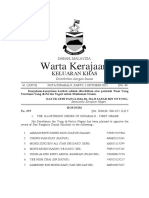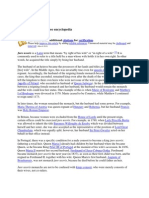DELICAN, Mutafa. Elite Theories of Pareto, Mosca and Michels PDF
DELICAN, Mutafa. Elite Theories of Pareto, Mosca and Michels PDF
Uploaded by
Jonas BritoCopyright:
Available Formats
DELICAN, Mutafa. Elite Theories of Pareto, Mosca and Michels PDF
DELICAN, Mutafa. Elite Theories of Pareto, Mosca and Michels PDF
Uploaded by
Jonas BritoOriginal Title
Copyright
Available Formats
Share this document
Did you find this document useful?
Is this content inappropriate?
Copyright:
Available Formats
DELICAN, Mutafa. Elite Theories of Pareto, Mosca and Michels PDF
DELICAN, Mutafa. Elite Theories of Pareto, Mosca and Michels PDF
Uploaded by
Jonas BritoCopyright:
Available Formats
ELITE THEORIES OF PA RETO, MOSCA AND MICHELS
Dog. Dr. Mustafa Delican
I - INTRODUCTION
Studies on elites have been one of the largest subject in social sciences
particularly in sociology and political sciences. This emphasis is mostly due to
undeniable effects and roles of elites in societies developed or developing.
Interestingly, most of these studies hardly cover the studies of founder of elite
theories. Elite theories introduced not only elites, but also new important subjects
like power, and rose questions for example on oligarchical tendencies in
democracy. Unfortunately, more studies have been done on elitist theories' ideas
on political subjects than their ideas on social thoughts.
In this study I will work on the classic elite theories, namely Pareto's
Circulation of Elites, Mosca's theories of Ruling Class, and Michels' theory of Iron
law of Oligarchy and I will not get into neither the subject of Power Elite nor elites
roles in today's societies particularly in developing countries. Therefore, my focus
will be on political elites in the writings of Pareto, Mosca^and Michels. First I will
summarize their theories and then I will critic and evaludfe them by comparing
each other in terms of similarities and differences, their contributions on social
thoughts, understanding social life, social and political movements, and their direct
and indirect effects on democracy.
H- PARETO: THE LAW OF CIRCULATION OF ELITES
Pareto says that people are always governed by elites except short period
of time. He rejects a linear progressive evolutionary interpretation of history and
social change. For him, "[hjistory of men is the history of the continues
replacement of certain elites as one ascends another declines, such is the real
phenomenon, though to us it may often appear under another form" (Pareto 1968,
p.36).
The notion of elite had been known before pareto. He himself also used
Kolabinska's study, who was also one of Pareto's student, " La Circulation des
Elites en France" as a reference source. To Pareto elites are those people who
posses in marked degree qualities of intelligence, character, capacity, of what ever
kind. More precisely if we grade every individual regardless of any ethical
judgment, according to their branch activity and occupation in the society, we find
at each grade level there will be a certain amount of individuals, that consists of a
class. In this class hierarchy, people who are in the class which is on the top of the
other classes are called, "elite" (Pareto 1935, p.1421 footnote 2026'; 1422-23).
324
MUSTAFA D E L l C A N
Then, Pareto classifies social classes by taking elites as a stickyard. Elites
represent the higher stratum, the others, namely non-elites are thought as the
lower stratum. He further emphasizes and divides it into subgroups, because for
him, there is no one elite stratum. There are various strata in it and all of them
constitute the elite stratum. The main strata in elite stratum are (a) governing elite
that consists Of rest of the individuals who directly or indirectly have a
considerable role in government; (b) non-governing elite that consists of rest in the
elite stratum; (c) political elite that effectively and particularly, exercise political
power. The elite or upper stratum or aristocracy ( Pareto uses these terms
interchangeably ) contains a certain number of people, but it cannot be sharply
defined because social classes like societies are not homogeneous and they are not
entirely distinct to each other even in a caste system and particularly in societies
where class circulation is extremely rapid like modern societies
( Pareto,
1935, pp 1419,1423-1424,1429,1575; Pareto 1968, p. 78).
Pareto examines structure and change of elites rather than non elites. This
is mostly due to availability of historical data according to him. Elites and nonelites are not stable, they are subject to change. New elitesriseand takes old elite's
place. This change is called the law of circulation of elites by Pareto. He says
"elites" or aristocrats do not last. They live or take position in a certain time.
"History" , he says, "is a graveyard of aristocracies" ( Pareto 1935, p. 1430). In
course of the time, elites undergo a change when elite member's composition
change or their descendants do not have qualities to be elite; or, infiltration of
extraneous elements from lower classes and another society, or, changes in legal
rights in society like extension of right of citizenship that gives an opportunity for
non-elites to move up( Pareto 1935, p. 169).
Rising and declining of the elites take place at the same time. Generally
there are two signs that show elites are declining: (1) declining elite becomes
softer, milder, more humane and less apt to defend its own power; and (2) elites
loss its rapacity and greed for the goods of others, but rather tends as much as
possible to increase its unlawful appropriations and indulge in major usurpation of
the national patrimony ( Pareto 1968, p. 59). In contrast newrisingelites are active,
stronger and dedicated in character.
The circulation of elites in ruling class is more clear than general
circulation of elite. Governing or ruling elite is always in a state of slow and
continuous transformation. The transformation is basically based on change in
residues of ruling elite. Change in the proportion of Class I ( combinations ) and
class II ( Persistence of aggression ) residues leads to replacement of ruling elite.
Because relative proportions of class I and class II residues principally determine
social equilibrium, and make possible for elite to stay in power. In course of time,
ruling class becomes weak in class II residues and loose its strength. In this case,
people who are strong in class II residues rise upwards into the governing class
E L I T E THEORIES OF PARETO, MOSCA AND MICHELS
325
either by gradual infiltrations ( class circulation ) or in sudden spurt through
revolution ( Pareto 1935, pp. 1428-29, 1556 ). Ruling class follows various
ways to protect itself from the threats of non-elites such as using force; death;
capital punishment, financial ruin, exclusion from public offices, exile and
ostracism. On the other hand, ruling class recruit the individuals from lower strata
in order to fulfill its gap in both Class I and Class II residues and also eliminate the
individuals who are potential threat for ruling class itself. Recruitment must be
controlled otherwise it can lead corruption of ruling class because when one
moves up, he also brings his inclinations, sentiments and attitudes. Another way to
control ruled class is device (Pareto 1935, pp 1426,1787-97).
Considering means to control the subject classes, Pareto divides political
elites into two groups: (1) "foxes" who are strong in Class I residues and (2)
"lions" who are strong in Class I I residues. While foxes prefer to rule through cooperation, diplomatic intrigue, and deviousness, Hons prefer to rule through the use
of force
(Powers 1987, p 41).
Foxes and Hons live under any type of political structure, their attitudes are
not affected or shaped by the form of government. He says "Whatever the form of
government, men holding power have as a rule a certain inclination to use that
power to keep themselves in the saddle, and, to abuse it to secure personal gains
and advantages"( Pareto 1935, p. 1608).
In fact all governments use force but no government can rule by
depending solely on force. Theories designed by ruling class and derivations are
used to convince the subject classes to obey the government, and, to justify
government policies, and, to use visible force like army ,and, invisible force like
political machine . In addition to these, sentiments of superiority and inferiority are
used to keep ruled class in order. (Pareto 1935, pp. 686-87, 1526-27, 1534, 1541,
1585).
General condition of society is of particular importance for the ruling
class's position. When a governing elite establishes its control over the subject
classes by using force and providing great wealth , the ruling class survive
sometime without using power, but it also survives by granting its adversaries, in
terms of money, dignity and respect. Bargaining, concessions, and deceive are
also this kind of policies. Economic prosperity not only keeps the ruling class in
power and makes easy to govern society than period of depression, but also
affects the type of political regimes. For example in prosperity periods, there is a
tendency to shift from oligarchic regimes to democratic regimes ( Pareto 1935,
pp. 1431-32,1636).
On the other hand, general conditions of society shapes the type of
circulation of elites: soft and violent. Soft replacement of elites comes through the
change of supply to and demand for certain social needs or elements. For example
326
MUSTAFA DELCAN
when there is a war, more soldiers are required. Rising armies and military elites
change the balance among the social classes and diminish the power of old elites. It
happened in Europe when rising of strong military armies collapsed aristocracies
(Pareto 1935, p. 1426). Violent circulation of elites is via revolutions.
Accumulations in elite strata and failing to use force by political class lead to
revolutions, when elements of superior quality in lower class come to fore and this
lower class is willing to use force (Pareto 1935, p. 141).
The battle between ruling class and ruled class is always subject to
manipulations. Both sides, old elite and new elites, declare that they are not
fighting or working for their interests but for the good of the many. Of course
when the victory is achieved, one side looses and other side gains. After this
political revalry, who wins , will get the lion's share of the distribution of wealth,
power, prestige in the society. The type of policy necessary to get these goals will
be employed including force. Elites particularly ruling class, are well aware of
heterogeneity of individuals, unequal distribution of material, and non-material
assets in the society, and their interests. Further more, in contrast to masses, ruling
elite involves more logical actions than illogical , that makes elites more flexible
and awake for their own interests.
i n - MOSCA: THE RULING CLASS
Like Pareto, Mosca says that in any type of society at any point of history,
there are two class of people- a class that rule and a class that is ruled. The former
contains a few number of people and posses all political power and privileges
whereas the latter consist of large number of people and is subjected to rule of
former and provides essential instrumental for political organization (Mosca 1939,
p.50).
For Mosca, two political facts have to be considered in order to analyze
the relationship between ruling class and ruled class. The first fact is that there is
always one person who is the leader of political organization among the ruling
class. This individual is not necessarily the person who holds the highest
politicalposition according to law. Even he is not necessarily known by
everyone. This person, for example can be prime minister of king or president or
the person makes the president to be elected. Under certain conditions, this
supreme power can be in hand of more than one person. The second fact is
regardless of the type of the political organization , pressures of masses to ruling
class and its policies. Therefore, ruling class, or the head of the state, must be
sensitive about thought and feelings of the masses to get their support, otherwise
he cannot rule. For this reason, at least a large group from the masses is created
to support the ruling class and the system (Mosca 1939, pp.50-53).
The logic of ruling class, for Mosca, is simple: the ability to be organized
easily and effectively. Minority is always organized; therefore, it has ability to
overcome the majority. To Mosca this relation and its outcomes are inevitable.
E L I T E THEORIES OF PARETO, MOSCA AND MICHELS
327
Formation of the ruling classes has a close relation with the level of
civilization and the type of society. Ruling class under every condition try to
reproduce itself particularly by domination on political forces like power, wealth
and the ruling class tends to be come hereditary. In fact, descents of ruling class
members have a high life chances to have the traits necessary to be a ruling class
member (Mosca 1939, pp. 60-61). In general, prior to democracy, membership of
ruling class was not only de facto but also de jure. In democracy, de jure transfer of
political possession to descendants of ruling class members impossible and not
legitimized but it is now de facto.
According to Mosca, historically, ruling class try to justify its existence
and policies by using some universal moral principles, superiority etc., lately,
scientific theory and knowledge like Social Darwinism, division of labor is also
employed for the same purposes. Mosca particularly rejects these two theses to use
in political purposes. To Mosca, at a certain level of civilization, ruling classes do
not justify their power exclusively by de facto possession of it, but try to find a
moral and legal basis for it. This legal and moral basis or principles on which the
power of the political class rests is called "political formula" by Mosca. The
formula has a unique structure in all societies. "lT]he political formula must be
based on the special beliefs and the strongest sentiments of the current social group
or at least upon the beliefs and sentiments of the particular portion of that group
which hold political preeminence "(Mosca 1939, p.71,72).
In fact ruling class like Pareto's elite strata consist of two strata: (a) the
highest stratum; and (b) second stratum. The highest stratum is the core of the
ruling class but it could not sufficiently lead and direct the society unless the
second stratum helps. Second stratum is the larger than the higher stratum in
number and has all the capacities of leadership in the country. Even autocratic
systems do have it. Not only political but also any type of social organization
needs the second stratum in order to be possible (Mosca 1939, p.404,430).
The members of the ruling class should be recruited almost entirely from
the dominant, majority group in the society. If the society has a number of
minorities and if this rule is not followed due to weaknesses of dominant group,
political system can meet serious political crisis. The same thing occurs when there
are considerable differences between in the culture, and in customs of the ruling
class and subject classes (Mosca 1939, p.105,106-7).
Weaknesses of dominant group in society and isolation of lower classes
from the ruling classes can lead to political upheaval in the country and as a result
of this upheaval subject classes' representatives can have places in the ruling
class. Because when isolation takes place, another ruling class emerges among the
subject classes that often hostile to the old ruling class (Mosca 1939, pp. 107
8).Furthermore, due to reciprocal isolation of classes, the character of upper classes
change, they become weak in bold and aggressiveness andricherin "soft"
328
MUSTAFA DELCAN
remissive individuals. On the same track , when there is fragmentation in the
society, new groups form and each one of them makes up of its own leaders
and followers. Besides these revolutions are another source of replacement of
ruling class (Mosca 1939, p.163,199).
When Mosca compares the political systems, he says that communist and
socialist societies would beyond any doubt managed by officials and he sees these
regimes as Utopia. On democracy, he says, although gradual increase of universal
suffrage, actual power has remained partly in wealthiest and the middle classes. At
the same time, for Mosca, middle class is necessary for democracy, and when
middle class declines, politic regimes in democratic countries turns to a plutocratic
dictatorship, or bureaucratic dictatorship. (Mosca 1939, p.391).
According to Mosca, ruling class has a responsive character to social
change in the society and there is a close relation between level of civilization and
character of ruling classes. According to these two complementary proposition, it
can be said that ruling class is subject of social change rather than actor of it. For
example, change in division of labor from lower to higher and change in political
force from military to wealth have changed the type of state from federal to
bureaucratic state (Mosca 1939, p. 81, 83 ). There it seems that Mosca admits a
linear social change in history, as opposite to Pareto.
As seen, Mosca's theory is basically based on organized minorities'
superiority over unorganized majority. This organized minority consists of ruling
class, but for Mosca it is not necessarily mean that always interest of ruling class
and subject classes are different. To him ,in contrast they coincide many times. He
saw the future of socialist system by saying that it will be governed by officials.
This feature of socialist system is well documented by Milovon Dijilas in his
work: New Classes. But Mosca failed to see that one day, majority will also be
able to organize. As C. W. Mills pointed put, democratic western societies have
experienced important transformations: (1) from the organized minority and
unorganized majority to relatively unorganized minority and organized majority,
and (2) from the elite state to an organized state.( Mills 1965, pp. 161-162).
Therefore minorities and elites in todays' society are less powerful than majorities.
Elites have relatively lost their privileges, and more importantly, their monopoly
over society.
IV- MICHELS: THE IRON LAW OF OLIGARCHY
To Michels organizations are the only means for the creation of a
collective will and they work under the Iron Law of Oligarchy. He explicitly points
out the indispensability of oligarchy from the organizations by saying that "It is
organization which gives birth to the domination of the elected over electors, of the
mandatanes over the mandators, of the delegates over delegators, who says
organization, says oligarchy" (Michels 1966, p.365).
E L I T E THEORIES OF PARETO, MOSCA AND MICHELS
329
Oligarchical tendencies in organizations is not related to ideology or ends
of the organizations. Of course, it is evident that any organization which is set up
for autocratic aims , it is oligarchic by nature. To Michels, regardless of any
ideological concerns, all types of organizations have oligarchic tendencies. It was
his major question in political parties that "how can oligarchic tendencies be
explained in socialist and democratic parties, which they declared war against it?"(
Michels 1966, pp. 50-51).
When he examines this question throughout in his book: Political Parties,
he sees organization itself particularly bureaucracy, nature of human being and the
phenomenon of leadership as major factors for oligarchical tendencies in
organizations. According to Michels assessments, the crowd is always subject to
suggestion and the masses have an apathy for guidance of their need. In contrast
the leaders have a natural greed of power ( Michels 1966, pp. 64, 205). To
Michels, leadership itself is not compatible with the most essential postulates of
democracy, but leadership is a necessary phenomenon in every form of society.
He says "At the outset, leaders arise spontaneously, their functions are
ACCESSORY and GRATUITOUS. Soon however, they become professional
leaders, and in this second stage of development they are stable and irremovable"(
Michels 1966, p. 364).
Leaders also have personal qualities that make them successful as a ruling
class. These qualities are , the force of will, knowledge, strength of conviction, self
sufficiency, goodness of heart and disinterestedness ( Michels 1966, p. 100 ).
Furthermore there is a reciprocal relationship between leadership functions and the
organizational structure. Majority of leaders abuse organizational opportunities for
their personal aims by using their personal qualities and by creating means,
organizational process or principles like party discipline.
As for as organization itself is considered as a source of oligarchy,
Michels says that it is generally because of "PSYCHOLOGY OF
ORGANIZATION ITSELF, that is to say, upon the tactical and technical
necessities which result from the consolidation of every disciplined political
aggregate."( Michels 1966, p. 365). Further as a particular type of organization
bureaucracy and its features require an oligarchic structure.
At the societal level, although development in the democracy, oligarchy
still exists. First of all he says by looking at the state as an organization, which
needs a bureaucracy that is the source of enemy of individual freedom, the state
represents a single gigantic oligarchy. An attempt to destroy this gigantic'
oligarchy in fact brings a number of smaller oligarchies in society but does not
eliminate it ( Michels 1966, p. 188,191,202). Secondly he agrees with Jean Jack
Rousseau on the idea that "it is always against the natural order of things that the
majority rule and the minority ruled." (Michels 1965, p. 106). Along with this idea
professional leadership is seen by Michels as an incompatible phenomenon with
1
330
MUSTAFA DELCAN
democracy, because , although the leaders at once are not more than executive
agents off collective will, as soon as they gain the technical specialization, they
emancipate themselves form the masses and start to use their power against the
majority. ( Michels 1966, p.70). In addition to this, representative political
system is not compatible with the ideal democracy, because to Michels, "a mass
which delegates its sovereignty, that is to say transfer its sovereignty to the hands
of the few individuals, abdicates its sovereign function
( Michels 1966, p.
73).
The third factor is related to level of socio-economic development of
societies and experience of democracy in history. To him in this time ideal
democracy is impossible due to socio-economic conditions, that further more he
says that," The democracy has an inherent preference for the authoritarian solution
of the important questions" (Michels 1966, p. 51, 342).
As a logical result of his iron law of oligarchy, he admits there are elites
in society but not elite circulation in terms of replacing one another. He does not
redefine the concept of elite, he took Pareto's theory of circulation of elites and
modified it. To Michels, there is a battle between the old and new elites, leaders.
The end of this war is not an absolute replacement of the old elites by the new
elites, but a reunion of elites, a perennial amalgamation. Complete replacement of
elites is rare in history. The old elites attract, absorb and assimilate the new ones,
and it is a continuous process (Michels 1966, p. 182, 343; Michels 1949, p. 63).
Because for Michels, first" old aristocracy does not disappear, does not become
proletarian or impoverished ( at least in absolute sense ), does not make way for
new group of rulers , but that always remains at the head of nations, which it led
over the course of centuries...[and second]...the old aristocracy be it very old
rejuvenated, does not exercise the rule alone but is forced to shave it with some
kind of new ruler"
(Michels 1965,p. 75-76).
Aristocracy for Michels is not homogenous stratum, and consists of
nobility and ruling class. Nobility represents a small but strong part of aristocracy.
In this sense it seems that nobility represents real oligarchical power in the society.
To Michels nobility holds itself at the helm and does not even dream of
disappearing from the stage of history. Though not coinciding with aristocracy,
and not constituting more than a part of it, nobility generally takes hold of it and
makes itself its master. It pervades, conquers, and molds, the high middle class
according to its own moral and social essence" ( Michels 1949,p. 77, 80 ). In
contrast to nobility aristocracy is heterogeneous and a place where lower classes'
members can easily rise and members of aristocracy can be subject to downward
social mobility. For his time, he describes elements of aristocracy (1) aristocrats by
birth (2) aristocracy of government clerks, (3) aristocracy of money (4) aristocracy
of knowledge. All this groups also represent ruling class (Michels 1965, p. 76).
E L I T E THEORIES OF PARETO, MOSCA AND MICHELS
331
Michels does not get in too much special analysis of the relationships
between aristocracy, ruling class and majority. I think he doesn't see that there
are much differences in oligarchy in organization and oligarchy in society at
large.
To me these two must be separated because (1) for individuals society in a
sense an unavoidable place to be in contrast to organizations, particularly voluntary
organization , (2) while society represent a more natural entity, organizations are
more artificial entities and (3) organizations are set to realize certain targets in a
certain period of time, in contrast society's targets are relatively unstable, and
subject to reconstruction by people. To think of these questions, does not
necessarily reject the existence of oligarchical tendencies in societies. In fact as
Michels pointed out democracy has a legacy to solve important questions of
society, by using oligarchic methods. Furthermore he also points out that at any
social organization there is an intermixture of oligarchic and democratic
tendencies. He says that"... In modern party life, aristocracy gladly present itself in
democratic guise, while the substance of democracy is permeated with aristocratic
elements. On the one side we have aristocracy is a democratic form, and on the
other hand democracy with an aristocratic context" (Michels 1966, p.50).
V- CRITICS AND EVALUATION OF ELITE THEORIES
Elite as a concept has been a key term in social science although many
times it has been used without reference to Pareto, Mosca and Michels. Relatively
few works have been done on elite theories and their theorists. Further more, even
today a few of studies of theoreticians of elites have been translated to English.
One of the work of Vilfredo Pareto the transformation of democracy, has recently
translated to English in 1984. Therefore I could say that critics and evaluation of
elite theories and elitists have deficiencies. In addition in man y of books on
selection in social sciences have excluded the study of the founders of elite
theories, although there are sections on elites in these books. For example in Frank
and Lindenfeld ( eds.) Reader in political Sociology ( 1968) and J.S. Finkle and
R.W. Gable ( eds.) Political development and social change( 1966) have written
about elites, but don't have any text from Pareto, Mosca or Michels. In contrast, in
reality, elites roles in societies particularly in developing countries have been a
great deal studied and researched. I could think of two reasons for exclusion of
these big elitist theorists in the literature. The first reason could be ideological
particularly Marxist and Socialist thinkers are inherently against elitists theories
and the second reason could be abolition of the meaning of elite concept from
elitist theorists definition and reconstruction of the meaning of elite concept.
As far as critics of elite theories are concerned, the emphasis have largely
been on the relation between democracy and elite theories. This tendency is mostly
by anti-democratic reputation of elitist theorists. In contrast there have been less
emphasis on elite theories contribution on understanding on social stratification,
332
MUSTAFA DELCAN
obstacles for social mobility , distribution of power, wealth and status in societies
as well as organizations.
Pareto, Mosca and Michels are also labeled as Machiavellians. This label
is due to three reasons. (1) All of them are Italians. (2) They basically belong to
the same thought of school and (3) to spread negative reputation of Machiavelli to
these three thinkers. The question is that why elitists theories were born in Italy at
the turn of century. Two answers have been given. First is that Machiavellian
tradition in Italy. The second answer finds a direct relationship between elitist
theories and backward development of Italy at the turn of century. According to
Meisel, "Both [ Mosca and Pareto] reacted to the general consequence of the
industrial revolution, but they comprehended it in their own specifically Italian
context. Their country was a backward province of world capitalism (Meisel
1965(a), p. 6). On the same line G. Lukacs says that lack of genuine bourgeois
democracy in Italy led them to emphasis on political leadership( Bottomore 1964,
p. 9-10). These answers without doubt have reality but we have to also consider
that, Italy was not an isolated country from the rest of Europe. Further
autobiographies of theorists clearly show that they have close relation with other
countries physically and academically. Therefore these two reasons are not enough
to explain the source of elitism in Italy.
Circulation of elites more specifically, in the realm of politics, ruling class
is the main concern of Pareto, Mosca and Michels. All of them analyze the
structure of elites, social stratification in society, social mobility upward and
downward, relation among the elite strata and relation between .elite and non-elite
classes; and socio-economic, political and historical conditions' effect on these
phenomena and relationship among them. The great emphasis is given to
distribution of power , status and wealth , and the battle among the classes to get
lions' share in the power, wealth and status in society.
From a larger perspective, it is the socio-economic change and ideology
( or religion as Pareto and Mosca call) shape new classes. To me even Pareto's
residues move in these large perspective. Once new classes are formed they
become new social and political forces in society and try to move up into the upper
strata. This process is well explained in Pareto's latter work: The transformation of
Democracy. He says that as a result of changes in societies in 19 century two
classes are rising: the class of wealthy speculators and the class of wage earners.
At the same time power of two classes is declining: The class of property owner
and the military class. In terms of future political structure he says,"... the growing
power of wealthy speculators might be viewed as "plutocratic" tendency, while the
growing power of wage earners might be viewed as democratic tendency", and, he
adds" these two classes can be thought as having in some sense, cooperatively
united, or formed a partial ally (Pareto 1984, p 55 ). Here each class has a special
ideological tendency, compatible with his own class interests. These two
th
E L I T E THEORIES OF PARETO, MOSCA AND MICHELS
333
tendencies remind us to consider Michels proposition of intermixture of political
structure: autocratic tendency and democratic tendency. Mosca also has this dual
tendency. He says when authority transmitted from above, aristocratic principles
are at work and that when authority is based on a part or all of people, liberal
principles are at work. ( Meisel 1965(b), p. 165 ).
In terms of replacement of old elites by new ones, there is a distinction
between Pareto and Michels. Michels does not admit replacement of elites, but
admits, amalgamation of new and old elites. In fact historically we can see both of
them happened. In short term amalgamation of old and new elites, and in long
terms replacement of old elites by new ones. This time period depends on changes
in society at large. For example, consider socialist revolutions and aftermath of
independent movement in developing countries where these two movements took
place, old elites were wiped out. This type of changes are rarely in history. In short
term, amalgamation of elites takes place and new elites gradually increases its
proportion in the elite strata and ruling class. For example as a result of
industrialization in Europe, Hughes observes that at the beginning "...upper class
oligarchy shared power with the old aristocracy-but with each year that passed the
balance seemed to incline more heavily in favor of the former" (Hughes 1965,
pp.149-150). It can be concluded that new elites are born as a result of socioeconomic , political, and historical changes in society, and then these new elites via
upward mobility, and that in the end the new elites take place the highest position
in the society. In this process the adaptation ability of old elites determine their
fates.
On democracy, Pareto always separate ideal democracy and democracy
applied, and prefers to talk about the subjects of democracy rather than
democracy itself. Michels is clearly in favor of democracy. Mosca was
previously against democracy but after the experience of Fascism in Italy, he
changed his mind.
How elitist theories affected democracy ? Two answers have given for
this question. On the negative side, it has been said that these anti-democratic
theories helped European ruling classes by restoring their self confidence and by
increasing their consciousness about their privileges; therefore, elite theories
become a vehicle for ruling classes (Hughes 1965 (b), p.149). On the positive side,
it has said that elitist theories have helped to enhance democratic theories. Michels
himself believed that research on oligarchies necessary for development of
democracy by saying that "...a serene and frank examination of oligarchical
dangers of democracy will enable us to minimize these dangers,...(Michels 1966,
p.370).
It can be said that elitist theories extended and increased awareness of
masses and scientist against governments' and ruling classes. As a result, many
researches have been conducted on application of democracy in organizations.
334
MUSTAFA DELCAN
Researches have shown that oligarchical tendencies are dominant in organizations
and can not be eliminated totally. Further more, attempts to reduce oligarchic
contrgl in organizations with very few exception have failed. In general, in
voluntary organizations, the functional requirements of democracy con not be met
most of the time (Lipset, Trow, and Coleman 1956, p.4,6,452).
Is democracy still compatible with elite theories? That has been the
question that lead to redefine, reconceptualize the democracy. Here we must pay
attention that Pareto, Mosca, and Michels worked J.J. Rousseau's definition of
democracy: government by the people, but not government for the people
(Burnham 1943, pp. 156-7). New democratic theories like political pluralism,
theory of the mass society are compatible with elitist theories. Schumpeter was one
of the earliest thinker that he redefined democracy considering elitists' arguments.
To him democracy defined as "...institutional arrangement for arriving the power to
decide by means of competitive struggle for the people's vote" (Bottomore 1964,
p.10).
In contrast to compatibility of elitist theories' with democracy, it can not be
compatible with Marxism. Michels pointed out that "[t]he law of circulation of
elites destroy the thesis of the possibility of a society without social levels...[and]...
destroy equally the supposition of a ruling class that remains closed and
inaccessible" (Michels 1965, p. 106). In terms of preference of political systems he
clearly says that "the defects inherent in democracy are obvious. It is none the less
true that as a form of social life we must choose democracy as the least of evils"
(Michels 1966, p.370).
V I - CONCLUSIONS
Elitist theorists not only introduced elites but also contributed on better
understanding of social and political life of societies. The key concept is "power"
and who has the power she/he is the leader of society. Heredity, wealth, intellect,
organizations are the means to get power.
Pareto, Mosca, and Michels agree on that elites, aristocrats come to power
and all necessary policies and means are used in order to continue to be ruler and
protect their privileges. In contrast to Pareto and Mosca, to Michels an
amalgamation occurs among the rising elites and old ones rather than replacement
of the old elites by the new.
In terms of methodology, Pareto and Mosca used historical method in their
studies, but they took history as true knowledge. That was one of their weaknesses.
On the other hand, Michels analysis was based on more concrete data.
Another important commonalties of them is to reject to explain social
events by one factor. However, it seems that Psychological factors in Pareto's
theory and structural factors in Michels theory are dominant.
E L I T E THEORIES OF PARETO, MOSCA AND MICHELS
335
Lastly, elite theories contributed development of democracy by showing
the differences between theory, constitutional guarantines, and practical
application of democracy. That have led to create new and more realistic, viable,
and applicable theories on democracy.
BIBLIOGRAPHY
Bottomore, T.B. 1964. Elites and Society. London: C.A. Watt and Co. Ltd.
Burnham, James. 1943. The Machiavellians: Defenders of Freedom. New York:
The
John Day Co.
Hughes, H. Stuart. 1965. "Gaetono Mosca and the political lessons of history" pp.
141160 in Pareto and Mosca. J.H. Meisel (Eds.). Englewood Cliffs.
N.J.:Prentice- Hall.
Lipset, S.M., Trow, M.A., Coleman, J.S.. 1962. Union Democracy. Garden City,
New York: Anchor Books.
Meisel, James, H. 1965(a). "Introduction", pp. 1- 44 in Pareto and Mosca. J.H.
Meisel (Eds.). Englewood Cliffs. N.J.:Prentice-Hall.
1965(b). "Power Structure and Power Flow", pp. 165-169 in
Pareto and Mosca. J.H. Meisel (Eds.). Englewood Cliffs. N.J.:Prentice-Hall.
Michels, Robert. [1949] 1965. First Lectures in Political Sociology. New York:
Harper Torchbooks.
[1915] 1966. Political Parties. New York: Free.
Mills, C. Wright. 1965. "Notes on Mosca". pp 161-163 in Pareto and Mosca. J.H.
Meisel (Eds.). Englewood Cliffs. N.J.:Prentice-Hall.
Mosca, Gaetono. [1896] 1939. The Ruling Class. New York: McGraw Hill.
Pareto, Vilfredo. [1916] 1935. The Mind and Society. A Treatise on General
Sociology. New York: Dower.
[1901] 1968. The Rise and Fall of the Elites: An Application
of
Theoretical Sociology. New Jersey: The Bedminister Press.
[1921] 1984. The Transformation of Democracy. New
Brunswick.
New Jersey: Transaction Books.
Powers, Charles, H. 1987. Vilfredo Pareto. New Burry Park: Sage Publications.
You might also like
- KING AND QUEEN OF HEARTS PROGRAMME 2023-Finalizing1Document12 pagesKING AND QUEEN OF HEARTS PROGRAMME 2023-Finalizing1Jely Taburnal Bermundo100% (6)
- Packenham, Robert. Legislatures and Political DevelopmentDocument17 pagesPackenham, Robert. Legislatures and Political DevelopmentMireya SCNo ratings yet
- Economy of Permanence - J.C.kumarappaDocument219 pagesEconomy of Permanence - J.C.kumarappamonto.maniNo ratings yet
- Social Conservatives of The Left: Collier, Lasch, and Bell - Russell NieliDocument95 pagesSocial Conservatives of The Left: Collier, Lasch, and Bell - Russell NieliCocceiusNo ratings yet
- TRIMBERGER, Ellen. A Theory of Elite Revolutions PDFDocument17 pagesTRIMBERGER, Ellen. A Theory of Elite Revolutions PDFJonas BritoNo ratings yet
- TRIMBERGER, Ellen. A Theory of Elite Revolutions PDFDocument17 pagesTRIMBERGER, Ellen. A Theory of Elite Revolutions PDFJonas BritoNo ratings yet
- Flynn - Sartre, Foucault and The CritiqueDocument20 pagesFlynn - Sartre, Foucault and The CritiqueAlvaroNo ratings yet
- Media Hegemony: January 2013Document5 pagesMedia Hegemony: January 2013SammiyaNo ratings yet
- Is Socialism Still An AlternativeDocument19 pagesIs Socialism Still An AlternativeMahalia GearyNo ratings yet
- A Critical Review of Barrington Moore's Social Origins of Dictatorship and DemocracyDocument35 pagesA Critical Review of Barrington Moore's Social Origins of Dictatorship and DemocracyjauncitoNo ratings yet
- Isaiah Berlin - Political JudgmentDocument8 pagesIsaiah Berlin - Political JudgmentPhilip PecksonNo ratings yet
- Kolakowski - TotalitarianismDocument10 pagesKolakowski - Totalitarianismel_ahrairahNo ratings yet
- Dewesternization and Islamization: Their Epistemic Framework and Final PurposeDocument18 pagesDewesternization and Islamization: Their Epistemic Framework and Final PurposeHaziq AsyrafNo ratings yet
- Fraser, A Triple Movement. Parsing The Politics of Crisis After Polanyi-2Document14 pagesFraser, A Triple Movement. Parsing The Politics of Crisis After Polanyi-2Julian GallegoNo ratings yet
- Red Toryism and The Politics of NostalgiaDocument20 pagesRed Toryism and The Politics of NostalgiarolandboerNo ratings yet
- Re Visiting Kenneth Burke - Dramatism:Logology and The Problem of AgencyDocument19 pagesRe Visiting Kenneth Burke - Dramatism:Logology and The Problem of AgencyTomas FontainesNo ratings yet
- Dialnet JMCoetzeesDiaryOfABadYear 3150096 PDFDocument10 pagesDialnet JMCoetzeesDiaryOfABadYear 3150096 PDFKhan SarahNo ratings yet
- Allan Bloom - The Political Philosophy of Isocrate PDFDocument237 pagesAllan Bloom - The Political Philosophy of Isocrate PDFNLarbaud100% (1)
- Flynn - The Evolution of Sartre's Political and Social ThoughtDocument24 pagesFlynn - The Evolution of Sartre's Political and Social ThoughtPete SamprasNo ratings yet
- Samuel Francis, "Beyond Conservatism"Document5 pagesSamuel Francis, "Beyond Conservatism"Anonymous ZwwcxXNo ratings yet
- Thymotic Politics: Sloterdijk, Strauss and NeoconservatismDocument37 pagesThymotic Politics: Sloterdijk, Strauss and NeoconservatismAnonymous Fwe1mgZNo ratings yet
- Pareto's Theory of Elite Cycles - A Reconsideration and ApplicationDocument26 pagesPareto's Theory of Elite Cycles - A Reconsideration and ApplicationHilwan GivariNo ratings yet
- Thompson EP - Agency and ChoiceDocument10 pagesThompson EP - Agency and ChoiceTom AllenNo ratings yet
- Deceive Me and Do It WellDocument5 pagesDeceive Me and Do It WellTomas ČiučelisNo ratings yet
- Woodrow Wilson On Socialism and DemocracyDocument5 pagesWoodrow Wilson On Socialism and DemocracyJohn MalcolmNo ratings yet
- Georges Sorel - Reflections On VilolenceDocument30 pagesGeorges Sorel - Reflections On VilolenceMaurício Mühlmann Erthal100% (1)
- Philosophy in Germany Critchley HonnethDocument13 pagesPhilosophy in Germany Critchley HonnethIdrilNo ratings yet
- Braudel Annales HalfDocument17 pagesBraudel Annales HalfShathiyah KristianNo ratings yet
- Winning of The West Vol. 1Document152 pagesWinning of The West Vol. 1lola larvale100% (1)
- John P. McCormick Machiavellian Democracy-155-202 PDFDocument48 pagesJohn P. McCormick Machiavellian Democracy-155-202 PDFEmilia Pagola OlceseNo ratings yet
- Otto Hintze His WorkDocument33 pagesOtto Hintze His WorkAnonymous QvdxO5XTRNo ratings yet
- Paul Goodman - Reflections On The Anarchist PrincipleDocument2 pagesPaul Goodman - Reflections On The Anarchist PrincipleStevo49100% (1)
- Constitutional Reason of State: The Survival of the Constitutional OrderFrom EverandConstitutional Reason of State: The Survival of the Constitutional OrderNo ratings yet
- Liberty: Freedom From, or Freedom To?Document6 pagesLiberty: Freedom From, or Freedom To?jdodman41No ratings yet
- Bayart Etal, Criminalization of The State in AfricaDocument32 pagesBayart Etal, Criminalization of The State in AfricajorgekmpoxNo ratings yet
- Ecological Psychology PDFDocument9 pagesEcological Psychology PDFAmanda Espinoza100% (1)
- Saward (2009) - Authorisation&Authenticity - Unelected RepresentationDocument22 pagesSaward (2009) - Authorisation&Authenticity - Unelected RepresentationAlexandra Mardale100% (1)
- Leo Strauss On The Understanding of The Politically Better and WorseDocument14 pagesLeo Strauss On The Understanding of The Politically Better and Worsehgildin100% (1)
- Jameson. Modernism As Ideology. 2002Document37 pagesJameson. Modernism As Ideology. 2002Jess and MariaNo ratings yet
- The Case Against Democracy - The New YorkerDocument9 pagesThe Case Against Democracy - The New Yorkersarwar sons100% (1)
- McCormick - Defending The People From The ProfessorsDocument8 pagesMcCormick - Defending The People From The Professorssebatorres7No ratings yet
- Contributions To The Realist Tradition in Political PhilosophyDocument19 pagesContributions To The Realist Tradition in Political PhilosophyIbtissem Ben KhaledNo ratings yet
- Guibernau Smith On Nations and National IdentityDocument17 pagesGuibernau Smith On Nations and National IdentityCharlène Ancion100% (1)
- What Is Political EconomyDocument8 pagesWhat Is Political EconomyEricha Joy GonadanNo ratings yet
- Critical Theory Post-StructuralismDocument13 pagesCritical Theory Post-StructuralismDeeksha ANo ratings yet
- The Expanding CircleDocument39 pagesThe Expanding CircleRmo DiegoNo ratings yet
- Machiavelli Against RepublicanismDocument30 pagesMachiavelli Against RepublicanismLaurie Kladky100% (1)
- PATTON, Paul - Foucault's Subject of Power - Political Theory NewsletterDocument13 pagesPATTON, Paul - Foucault's Subject of Power - Political Theory NewsletterAlekseiNo ratings yet
- Political PhilosophyDocument196 pagesPolitical PhilosophyDúber CelisNo ratings yet
- Barthes IntroDocument3 pagesBarthes IntroDarlene KeydeniersNo ratings yet
- Caffentzis Autonomous UniversitiesDocument21 pagesCaffentzis Autonomous UniversitiesStathis PapastathopoulosNo ratings yet
- 1965MarcuseRepressiveToleranceEng1969edOcr PDFDocument26 pages1965MarcuseRepressiveToleranceEng1969edOcr PDFConnor WoolfNo ratings yet
- Schmidt Review of DufourDocument2 pagesSchmidt Review of DufourjardelbtstNo ratings yet
- Herzen, Selected Philosophical WorksDocument641 pagesHerzen, Selected Philosophical Worksv_koutalisNo ratings yet
- French: Conservative ThoughtDocument16 pagesFrench: Conservative ThoughtDwebeyNo ratings yet
- Adorno ResignationDocument6 pagesAdorno ResignationRebecca O' DwyerNo ratings yet
- A Liberal Pentagram For Living TogetherDocument8 pagesA Liberal Pentagram For Living Togethersinteza_pressNo ratings yet
- Winch (2009) PDFDocument17 pagesWinch (2009) PDFXue MichelleNo ratings yet
- Hirschman-On Hegel, Imperialism and Structural StagnationDocument8 pagesHirschman-On Hegel, Imperialism and Structural StagnationhegelhegelNo ratings yet
- Critical Theory Crisis of Social TheoryDocument21 pagesCritical Theory Crisis of Social TheoryrofflewoffleNo ratings yet
- Internationalist Perspective 57Document36 pagesInternationalist Perspective 57SubproleNo ratings yet
- WOODARD, J. The Specter of LyberalismDocument9 pagesWOODARD, J. The Specter of LyberalismJonas BritoNo ratings yet
- SCOTT, Rebecca J. Defining The Boundaries of Freedom in The World of Cane PDFDocument34 pagesSCOTT, Rebecca J. Defining The Boundaries of Freedom in The World of Cane PDFJonas BritoNo ratings yet
- HIGLEY, John BURTON, Michael FIELD, G. in Defense of Elite Theory PDFDocument7 pagesHIGLEY, John BURTON, Michael FIELD, G. in Defense of Elite Theory PDFJonas BritoNo ratings yet
- KHAN, Shamus Rahman. The Sociology of Elites PDFDocument22 pagesKHAN, Shamus Rahman. The Sociology of Elites PDFJonas BritoNo ratings yet
- BOBBIO, Norbert. Gaetano Mosca and The Theory of The Ruling Class PDFDocument11 pagesBOBBIO, Norbert. Gaetano Mosca and The Theory of The Ruling Class PDFJonas BritoNo ratings yet
- Speech After Being Convicted of Voting in The 1872 Presidential ElectionDocument1 pageSpeech After Being Convicted of Voting in The 1872 Presidential ElectionKarey SmithNo ratings yet
- 06history6 Kings Nobles and PeasantsDocument2 pages06history6 Kings Nobles and PeasantsSzántó ErikaNo ratings yet
- Feudalism: in Anglo-Norman Feudalism, Were Somewhat As FollowsDocument4 pagesFeudalism: in Anglo-Norman Feudalism, Were Somewhat As FollowsMaría Belén TatoNo ratings yet
- Lessons in Arabic Language, Book 1 - Shaykh Dr. V. Abdur-Raheem, Islaamic University of MadeenahDocument125 pagesLessons in Arabic Language, Book 1 - Shaykh Dr. V. Abdur-Raheem, Islaamic University of Madeenahلطفية المحبوبةNo ratings yet
- Feudalism Feudum: FiefDocument11 pagesFeudalism Feudum: FiefSamiha Lubaba 1510806645No ratings yet
- Social Classes in Midle AgesDocument11 pagesSocial Classes in Midle AgesStefan LaurentiuNo ratings yet
- House of Liechtenstein - Wikipedia PDFDocument32 pagesHouse of Liechtenstein - Wikipedia PDFAngel Marie TisadoNo ratings yet
- 20 Common Forms of GovernmentDocument14 pages20 Common Forms of Governmentf nNo ratings yet
- Belajar Bahasa Arab Buku 1Document127 pagesBelajar Bahasa Arab Buku 1radiorodja100% (14)
- Lessons in Arabic Language, Book 1 - Shaykh Dr. V. Abdur-Raheem, Islaamic University of MadeenahDocument125 pagesLessons in Arabic Language, Book 1 - Shaykh Dr. V. Abdur-Raheem, Islaamic University of MadeenahIbnu AliNo ratings yet
- UCSP Module 7Document39 pagesUCSP Module 7jomari.rafael001No ratings yet
- Middle Ages Assignment PDFDocument7 pagesMiddle Ages Assignment PDFapi-292599931No ratings yet
- Tome 2 Medine PDFDocument223 pagesTome 2 Medine PDFZinsonni AmzaNo ratings yet
- Tome 2 Medine PDFDocument0 pagesTome 2 Medine PDFheisenberg10100% (1)
- Descr StratDocument178 pagesDescr StratbrixmayNo ratings yet
- Warta Kerajaan Keluaran Khas 2021Document47 pagesWarta Kerajaan Keluaran Khas 2021Andy AGNo ratings yet
- The Middle Ages: By: Kenisha C. RobinsonDocument12 pagesThe Middle Ages: By: Kenisha C. Robinsonreaders430No ratings yet
- Feudalism - WikipediaDocument72 pagesFeudalism - WikipediaTasaduq Ahmad 46No ratings yet
- ვუდრო ვილსონი - მეცნიერება საჯარო ადმინისტრირების შესახებDocument26 pagesვუდრო ვილსონი - მეცნიერება საჯარო ადმინისტრირების შესახებსოფიო ჯანელიძეNo ratings yet
- British Social SystemDocument4 pagesBritish Social SystemIrfan KhanNo ratings yet
- Demon-Cracy: PS 112A: Ancient Political Thought Paper#2Document10 pagesDemon-Cracy: PS 112A: Ancient Political Thought Paper#2Mansher DhillonNo ratings yet
- Oligarchy JA Winters (Summary)Document6 pagesOligarchy JA Winters (Summary)Duenne LathropNo ratings yet
- Fading Suns - Lordly Duties & DuelingDocument5 pagesFading Suns - Lordly Duties & DuelingJRSNo ratings yet
- AP8 Q2 Module 5Document10 pagesAP8 Q2 Module 5Ronaleen Valdevieso Isogon-ApusNo ratings yet
- The Spanish Royal FamilyDocument5 pagesThe Spanish Royal FamilyMa'at MutamuntatNo ratings yet
- Aristocratic Form of Government NewDocument18 pagesAristocratic Form of Government NewXerxes Tyrian Yaasir NapiloyNo ratings yet
- Jure UxorisDocument3 pagesJure UxorisXymon BassigNo ratings yet
- Conacul Conților de Roma Din Comuna Viziru, Jud. BrăilaDocument9 pagesConacul Conților de Roma Din Comuna Viziru, Jud. BrăilaFluidProfessor100% (1)
- Aristotle's Politics: A CommentaryDocument11 pagesAristotle's Politics: A Commentarycamestres baroco100% (1)


















